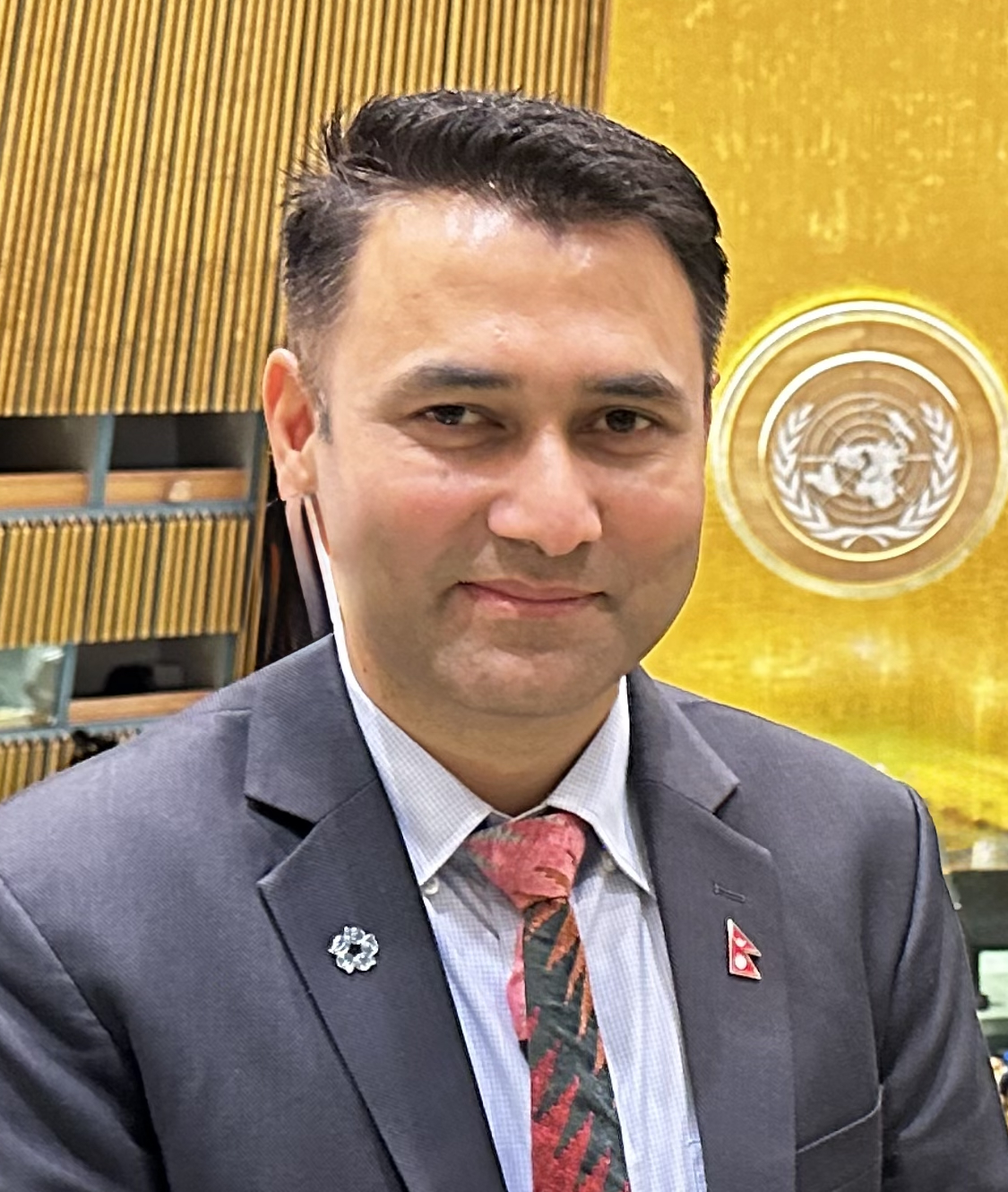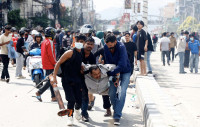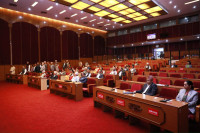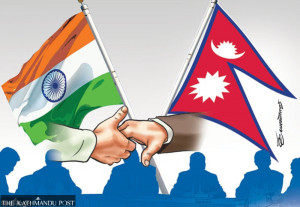Columns
Climate leadership from the frontlines
The Sagarmatha Sambaad sets an inspiring precedent for other climate-vulnerable nations.
Manjeet Dhakal
The confirmation that 2024 was the hottest year on record, with global temperatures reaching 1.55 degrees Celsius above pre-industrial levels, is a sobering reminder of how close we are to breaching the Paris Agreement’s 1.5 degrees Celsius threshold. Although we have not yet permanently crossed this long-term average temperature limit, the urgency to act—and the window for doing so—is rapidly closing.
Limiting global warming to 1.5 degrees Celsius is still achievable, but only if countries take decisive action to drastically reduce emissions within this decade. Delaying climate action will only intensify the negative impacts the world is already beginning to face. Rising temperatures, heavier rainfall and more frequent and intense extreme weather events are projected to cause up to $38 trillion in annual global damages by mid-century. Without bold mitigation efforts, the world not only risks escalating environmental disasters but also staggering economic losses.
Studies estimate that the cost of inaction could lead to a nearly 20 percent decline in global income by 2050. In South Asia, the figure is projected to be even higher—around 22 percent—with economically constrained countries facing even greater losses.
For climate-vulnerable nations like Nepal which are already struggling with melting glaciers, erratic monsoons and growing climate-induced disruptions across critical economic sectors such as agriculture, hydropower, and tourism, failing to meet the 1.5 degrees Celsius target poses a serious threat to both livelihoods and the overall economy. According to a study by Climate Analytics, the economic damage from not limiting warming to 1.5 degrees Celsius could shrink Nepal’s GDP by more than 16 percent by 2050.
Furthermore, the potential impacts of climate change on remittance flows, particularly with over 80 percent of Nepal’s migrant workforce based in regions like the Middle East and Malaysia, where warming is above the global average, remain underexplored. All these factors place Nepal squarely on the frontlines of the global climate crisis.
Nepal’s engagement
Over the past few decades, shifting global dynamics—including the rise of emerging economies, escalating geopolitical tensions and widening economic disparities—have added new complexities to climate negotiations. The traditional divide between developed and developing countries has become increasingly blurred, as some nations have experienced rapid economic growth while others remain highly vulnerable. These shifts have reshaped the architecture of multilateral negotiations, where equity, historical responsibility and differentiated capabilities remain central but highly contested themes.
Within this evolving landscape, climate diplomacy has become more fragmented due to widening ambition gaps and inconsistent implementation from major emitters. Still, coalitions such as the Least Developed Countries (LDC) Group, the Climate Vulnerable Forum and the High Ambition Coalition have emerged as vital champions for more urgent and equitable global climate action. Nepal’s active engagement in these platforms has helped amplify the specific concerns and vulnerabilities of mountainous and least developed countries.
Despite limited resources and capacity, Nepal has consistently demonstrated leadership in global climate processes. As a signatory to the UNFCCC since 1992 and to the Paris Agreement in 2015, Nepal has participated at the highest levels in major international summits. It has also submitted ambitious national climate plans—known as Nationally Determined Contributions (NDCs)—which outline its plans for adaptation and mitigation. In addition, national policies such as the National Climate Change Policy (2019), the National Adaptation Plan (NAP) and the Local Adaptation Plans of Action (LAPA) underscore Nepal’s strong commitment to climate-resilient development.
However, Nepal continues to face serious challenges in accessing adequate climate finance and technology, essential resources for translating plans into action. As a result, it has consistently called for enhanced international support, simplified access to finance and fair recognition of the disproportionate burdens faced by least developed and mountainous nations.
Sagarmatha Sambaad
Against this backdrop, the Sagarmatha Sambaad emerges as a timely and significant initiative. Named after Mount Everest—Sagarmatha, the world’s highest peak—it symbolises Nepal’s identity and moral standing as a frontline nation in the climate crisis. The Sambaad is a high-level, multi-stakeholder global dialogue designed to foster cooperation, share solutions and build solidarity across regions and communities.
The central theme “Climate Change, Mountains, and the Future of Humanity” reflects Nepal’s strategic intention to place mountain ecosystems at the heart of global climate discourse. Mountain regions, while contributing very little to global emissions, are among the most affected by climate change. Melting glaciers, erratic rainfall and rising climate-induced disasters not only threaten local communities but also impact downstream populations that rely on mountain ecosystems, contributing to sea level rise and threatening water security.
Sagarmatha Sambaad provides Nepal a global platform to showcase its pioneering practices—from community forestry and ecosystem restoration to renewable energy expansion and locally led adaptation planning. It helps shift Nepal’s narrative from that of a climate victim to a proactive, solution-oriented actor with valuable lessons for the global community.
For Nepali stakeholders, the Sambaad serves multiple purposes. It reinforces national ownership of climate action, raises the visibility of Nepal’s leadership and opens new avenues for international collaboration, investment and knowledge exchange. It also enables dialogue among diverse actors—government, civil society, academia, youth and indigenous communities—bridging global priorities with grassroots realities.
The Sambaad further strengthens Nepal’s domestic climate ecosystem. Through inclusive planning and engagement, it builds institutional capacity, enhances understanding of climate discourse and provides a platform for young professionals and experts to connect with global thought leaders. This, in turn, strengthens Nepal’s presence on the global stage and fosters long-term policy coherence.
Leadership from the frontline
As the world moves toward the next phase of climate negotiations—leading up to COP30 and beyond—the lessons from Sagarmatha Sambaad are clear. Today’s climate talks require stronger political will, grounded in scientific credibility, guided by visionary leadership and focused on the future of humanity, not short-sighted economic gains.
Nepal has shown that even countries with negligible emissions and high vulnerability can lead by example. In a context where few diplomatic gatherings are hosted by climate-vulnerable nations, Sagarmatha Sambaad stands out as a pioneering initiative. It demonstrates how a country can convene meaningful, evidence-based dialogue rooted in justice, equity and global solidarity.
The road ahead is undoubtedly challenging—but it is also full of possibilities. As climate threats continue to grow, so too must our resolve to act. Nepal’s leadership through the Sagarmatha Sambaad sets an inspiring precedent for others.




 10.12°C Kathmandu
10.12°C Kathmandu















